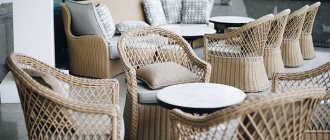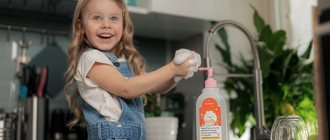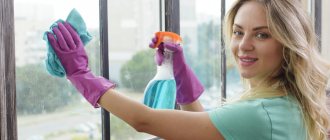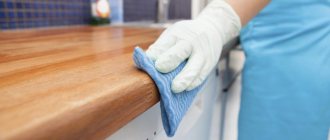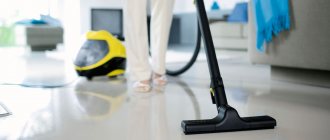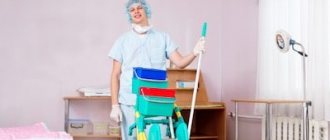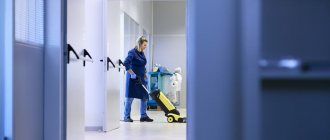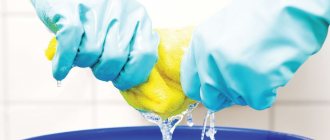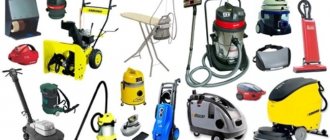Admission of medical personnel to cleaning
Personnel who have undergone vaccination and a full medical examination, noted in their personal medical record, are allowed to clean a medical facility.
Upon hiring, staff are given an introductory briefing, followed by repeated briefings. A nurse or cleaner should know:
- cleaning technology
- rules of sanitation and occupational hygiene
- purpose of detergents and rules for handling them
- basics of labor legislation
- internal labor regulations of a medical organization
- labor protection and fire safety rules
- methods of providing first aid in case of poisoning with disinfectants
The head of the organization approves the cleaning regulations, which includes information: the person in charge, who performs what type of work, in what rooms, and the frequency of cleaning.
Premises with a special operating regime can only be cleaned by specially trained personnel of a medical organization who have been instructed on the sanitary and hygienic regime and cleaning technology (clause 11.1 of Chapter I of SanPiN 2.1.3.2630-10).
Attention: all types of cleaning in the operating unit must be carried out by nurses under the direct supervision of operating nurses! You should not hire a cleaning company to clean the operation block!
Carrying out general cleaning: safety precautions
Carrying out general cleaning in a medical facility must be preceded by preparing two sets of protective clothing (gown, cap, mask, gloves). The first one is put on before cleaning. After the first stage of general cleaning, protective clothing must be removed, hands washed and treated with a skin antiseptic. Before the final (second) stage of general cleaning, a second set of protective clothing is put on.
Safety regulations
- The timing of deep cleaning should be such that it does not pose a risk of danger to patients and staff.
- To prevent injuries, fence off the area undergoing general cleaning with warning signs
- Before cleaning, secure electrical outlets, switches and lighting fixtures. Do not allow moisture to get inside.
- Use only certified inventory and technological equipment in accordance with the cleaning technology specified by the manufacturer
- Use disinfectants strictly according to the instructions in accordance with regulatory documentation
- Do not mix two or more detergents, cleaning agents or disinfectants. Mixing may result in a chemical reaction producing harmful substances that are hazardous to health if inhaled
- If the disinfectant solution comes into contact with unprotected skin or mucous membranes, rinse thoroughly with running water.
Read also: Production control in health care facilities: program, types, responsibilities
Necessary equipment
Equipment used in the treatment room should be stored separately from other cleaning equipment. Each item must be marked: special labels or signatures are made with oil paint.
We recommend:
How to choose a vertical vacuum cleaner for an apartment or home
Important! To wash different surfaces (floors, walls, windows), as well as medical furniture, different sets of equipment are used.
For general cleaning of the security office you will need:
- disinfectant liquid;
- spray gun and hydraulic remote control;
- buckets;
- mop;
- disposable wipes or sterilized rags.
All work is carried out in special clothing intended for cleaning. Employees will need a medical gown and cap, rubber gloves and replacement shoes. If necessary (for example, when mixing working solutions), wear safety glasses, a respirator or a rubberized apron.
Frequency of general cleaning
As planned, general cleaning is carried out according to a schedule approved by the head of the structural unit. The frequency of cleaning depends on the cleanliness class of the room. In rooms of cleanliness class A and B, general cleaning is carried out once a week, in the rest - once a month (clauses 11.7–11.8 of Chapter I of SanPiN 2.1.3.2630-10).
Each cleanliness class has its own requirements for operating mode and level of air and surface cleanliness. They are presented in the table “Permissible levels of bacterial contamination of indoor air”
| Cleanliness class | The name of a room | Operating mode | Risk to the patient |
| A | Operating rooms, maternity rooms, aseptic boxes for hematology and burn patients, wards for premature babies, aseptic block of pharmacies, sterilization room (clean half), boxes for bacteriological laboratories | Aseptic | High |
| B | Treatment rooms, dressing rooms, preoperative rooms, intensive care wards and rooms, children's wards, rooms for collecting and pasteurizing breast milk, assistant and packaging pharmacies, premises of bacteriological and clinical laboratories intended for research | Special | Average |
| IN | Surgical wards, corridors adjacent to operating rooms, maternity rooms, examination rooms, boxes and wards of infectious diseases departments, residents' rooms, material rooms, clean linen storage rooms | Ordinary | Short |
| G | Corridors and premises of administrative buildings, flights of stairs of medical and diagnostic buildings, sanitary rooms, toilets, premises for temporary storage of dirty linen and temporary storage of waste |
As a one-time event, general cleaning is carried out throughout the entire facility or in individual rooms during final disinfection, as well as for sanitary and hygienic indications in cases of unsatisfactory condition of the premises and in case of unsatisfactory results of microbial contamination of the external environment, after reconstruction, completion of current or major repairs, for epidemiological indications (clauses 1.4–1.5 of chapter II of SanPiN 2.1.3.2630-10).
Algorithm for cleaning the bathroom:
1. Disassemble everything that is piled out of place - put all dirty laundry in the wash or in a basket, hang towels on hooks or put towels on shelves, collect trash and anything that interferes with moving around the bathroom.
2. Remove the upper tier - wipe the shades or lamps, remove cobwebs, you can vacuum the corners.
3. Pay attention to the middle tier - wash the bathroom curtain or the upper parts of the cabin, clean up all the cabinets and shelves: take out all the vials and bottles, wipe the shelves, sort what you need, throw away what you don’t need, put what’s running out in front and write it down in a list shopping for everything you need to buy to replace it.
4. Wash the wall tiles and mirror.
5. Wash the shower stall, toilet, sink, bathtub. Clean and be sure to disinfect plumbing fixtures and faucets.
6. Clean the lower tier in the same way as the middle one - wash everything in the cabinets under the bathtub and sink, sort it, remove garbage, add what is running out to the shopping list.
7. Wash the baseboards and floor, wash or shake out the rugs, and leave the room to dry.
General cleaning technology
The general cleaning sequence includes several stages:
The preliminary stage is the preparation of the office or ward and cleaning equipment.
The first stage is applying disinfectant solutions in the correct sequence. From cleaner surfaces, such as ceilings and walls, move on to the most contaminated ones - equipment, switches, door handles, taps.
The second stage is wiping and washing surfaces, washing the floor, disinfecting the air, and ventilating the room. Air disinfection must be completed 60 minutes before the start of the office.
Algorithm for general cleaning
- There should be no patients in the room on the day of general cleaning.
- During general cleaning, the premises should be emptied of furniture and equipment as much as possible.
- Move furniture and equipment away from the walls and toward the center of the room to clean the walls and floor behind them.
- Unplug electrical equipment and devices.
- Install warning signs.
Attention: carry out all cleaning work wearing personal protective equipment and special clothing, which are specified in the instructions for the disinfectant. Do not wear open-toed or wet shoes.
- Cover surfaces and surrounding objects that are prohibited from being treated with chemicals with plastic wrap.
- Use separate sets of cleaning equipment for general cleaning in class A and B premises, in purulent dressing rooms, and diagnostic and treatment rooms of one structural unit. If there are medical devices and equipment installed in the room that come into contact with the patient, then prepare a separate container for their treatment.
To clean hallways and bathrooms, prepare separate sets of cleaning equipment.
- Prepare two sets of clean containers: separately for walls, windows, ceilings; furniture, instruments and apparatus; floor coverings; sanitary appliances. One is for disinfectant solution, the other is for clean water.
Attention: Use cleaning equipment according to letter markings or color coding.
- Prepare napkins of different colors for different purposes. For example, red napkins are for cleaning the toilet, gray ones are for wards, corridors, administrative premises, yellow ones are for sensitive rooms: treatment room, dressing room, intensive care ward, central care center.
- Disinfect surfaces.
- Disinfect surfaces with cloth wipes soaked in a disinfectant solution. To disinfect large surfaces, use several wipes. Change napkins when changing the object of treatment, as they become dirty. Consider the type of contamination.
Attention: do not use the same textile materials in different rooms without disinfecting and washing them.
- Also, do not wipe two or more surfaces with one side of the napkin. Napkins should be changed or turned over to the clean side when moving from one surface to another. For hard-to-reach places, use a spray disinfectant.
- Use disposable wipes with disinfectant solution in departments with a high risk of hospital-acquired infections and complications.
Read also: Using gloves. Sterile and non-sterile medical gloves
How to wash windows, walls, lamps and other items during general cleaning
- During general cleaning, clean, wash and disinfect by sprinkling or wiping window sills, doors, furniture, equipment, floors, walls to a height of at least 2 meters, and in operating units - to the entire height of the walls. Wash lamps inside and out, windows - inside once a month, outside - once every three months - in autumn, spring and summer.
- After the end of exposure to the disinfectant, wash all surfaces with clean cloth wipes moistened with tap drinking water.
Attention: when performing general cleaning of premises with aseptic operating conditions, use disinfectants that do not require rinsing with caution.
- These products have the property of fixing organic contaminants on surfaces and forming films on surfaces. There is a potential risk of formation of a focus of opportunistic and pathogenic microflora under the film: if the surface is not pre-cleaned, the treatment is carried out poorly, the concentration of the disinfectant solution is below normal.
- Finish the general cleaning with air disinfection.
Carrying out general cleaning using the mop method
To save labor costs and consumables, it is appropriate to introduce the mop method (bucketless cleaning method or pre-prepared napkin method) - a type of wet cleaning. The mop method saves cleaning time and increases productivity. The technology is permitted by clause 11.5 of section I of SanPiN 2.1.3.2630-10
To do this, prepare the required number of cleaning attachments and wipes before starting cleaning.
The bucketless cleaning method allows you to avoid two sets of clean containers and use one mop holder for all rooms of one structural unit, with the exception of the purulent dressing room, rooms of cleanliness class A and B, corridors and bathrooms.
The mop method allows you to wipe surfaces in one step without subsequent removal of the applied solutions. Make sure that the manufacturer indicates this method in the instructions for use of the product. A positive property of such agents is their prolonged antimicrobial effect.
At the end of the general cleaning, all inventory and equipment is disinfected, followed by washing and drying. protective clothing is disinfected and then disposed of (disposable) or washed (reusable).
After general cleaning, the nurse makes a note in the log indicating the date and percentage of disinfectant used. It is also necessary to make a note in the log about the air disinfection carried out after the general cleaning.
Read also: Preparation of disinfectants and rules for their storage in health care facilities
Algorithm for cleaning a bedroom, living room, nursery, office:
1. Remove the curtains, put them in the wash, wash the windows and cornices, and wipe off the dust on the windowsill.
2. Remove the upper tiers - remove the cobwebs from the ceilings and corners, wash the chandelier, wipe off the dust on the upper shelves and cabinets (after putting everything in its place).
3. Cleaning the middle tier - take apart all the things, hide the unnecessary ones, carefully fold the rest. Place the garbage in a bag and take it out of the room. Wipe down interior shelves, furniture fronts, handles, doors.
4. Take care of plants, clean surfaces and wipe the screens of equipment and gadgets.
5. Handle upholstered furniture - remove bedspreads and covers from the bed, vacuum everything carefully. Pillows that can be removed, taken out into the yard, knocked out.
6. Floors - vacuum soft surfaces, wash laminate, linoleum, etc. Wipe down the baseboards.
7. Open the window for ventilation.
